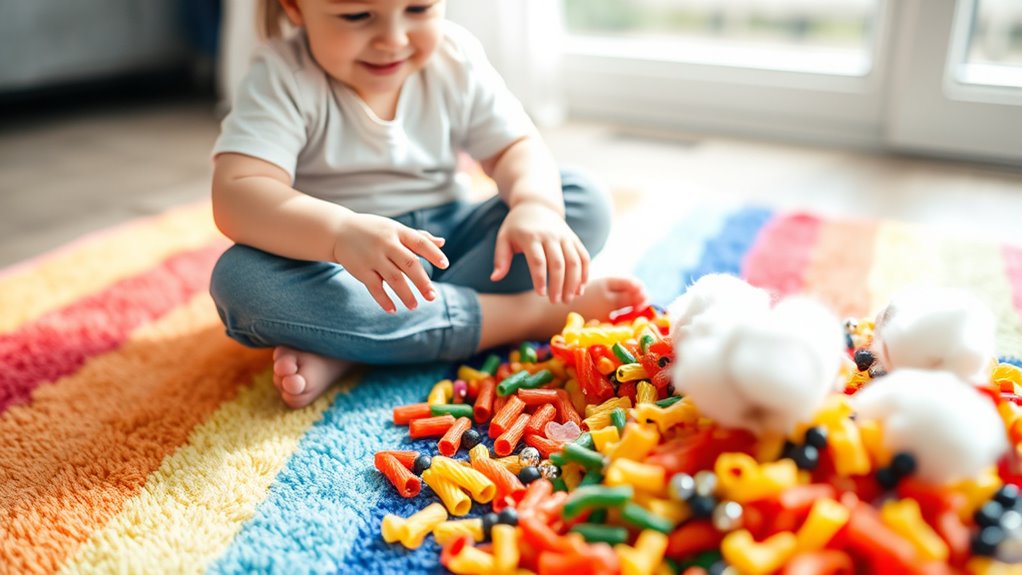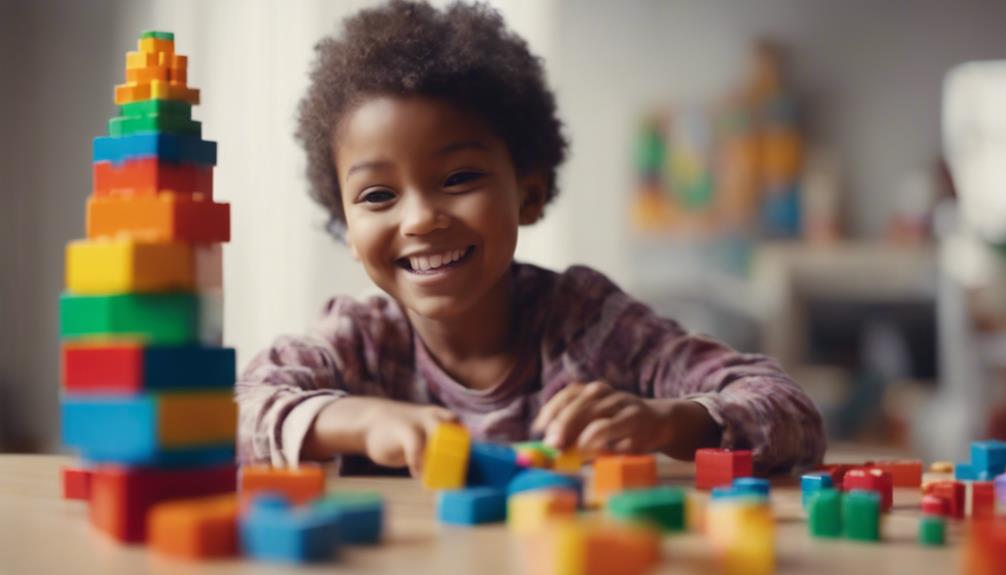Creating DIY sensory bins at home is a fun way to help your toddler develop critical skills like fine motor control, sensory processing, and curiosity. You can fill shallow containers with safe, everyday materials such as rice, pasta, or water beads, and add themed toys or tools for more engagement. These active, hands-on projects promote exploration and learning in a safe environment. Keep exploring to discover easy ideas and tips for customizing sensory bins to suit your child’s growth.
Key Takeaways
- Sensory bins promote tactile exploration, boosting sensory development and cognitive growth in toddlers.
- Using diverse materials and tools enhances fine motor skills like grasping and hand-eye coordination.
- Themed and customized bins engage toddlers’ interests while teaching concepts such as colors, animals, or textures.
- Safe, non-toxic materials ensure a fun, risk-free environment for independent and guided play.
- Sensory activities support critical skills like problem-solving, concentration, and sensory processing at home.

Creating DIY sensory bins is a simple and engaging way to boost your child’s development through play. These bins invite your little one to explore different textures, colors, and objects, making sensorial exploration an exciting part of their daily routine. As your child reaches in, scoops, and manipulates the contents, they’re not only discovering new sensations but also honing essential fine motor skills. The act of grasping small items, pinching, and pouring helps strengthen their hand muscles and improves coordination, laying a foundation for future writing and daily tasks.
Creating sensory bins boosts development through touch, coordination, and exploration in a fun, safe environment.
When you set up a sensory bin, you provide a safe and controlled environment that encourages curiosity. Fill a shallow container with various materials like rice, pasta, beans, or water beads, adding toys or utensils for more engagement. Your child will love digging through the different textures, which stimulates their sense of touch and enhances their ability to differentiate between sensations. This sensorial exploration isn’t just fun; it’s vital for their brain development, helping them process and interpret sensory information more effectively.
As your child plays, they’ll naturally develop their fine motor skills. Picking up tiny objects, transferring items from one container to another, or using tongs to grab objects challenges their hand-eye coordination and finger strength. These activities improve their precision and dexterity, essential for tasks like buttoning shirts, tying shoelaces, or writing. Plus, manipulating different materials introduces them to new tactile experiences, broadening their sensory vocabulary and fostering cognitive growth.
You can easily customize the sensory bin to match your child’s interests or developmental level. For example, if they love animals, include small figurines or themed items. If they’re just starting to learn about colors, incorporate brightly colored objects to enhance visual discrimination. The key is to keep the materials safe, non-toxic, and age-appropriate. Incorporate tools like scoops, brushes, or small shovels to encourage more refined movements, which further supports their fine motor development.
Frequently Asked Questions
How Can Sensory Bins Support Early Childhood Development?
Sensory bins support early childhood development by promoting sensory integration and fine motor skills. When you introduce different textures and objects, you help your child process sensory information more effectively. Manipulating small items in the bins strengthens their fine motor skills, like grasping and pinching. This hands-on play encourages exploration, enhances focus, and builds coordination, making it an engaging way to foster essential developmental skills in your toddler.
What Safety Precautions Should I Follow During Sensory Bin Activities?
Think of sensory bin safety like childproofing your home; it’s essential. You should always supervise your toddler closely, ensuring materials are non-toxic and age-appropriate. Check for small parts that could be a choking hazard and avoid sharp objects. Keep the area clean and sanitize materials regularly. By prioritizing material safety and childproofing, you create a secure space where your little one can explore confidently and safely.
Are There Sensory Bin Ideas Suitable for Different Age Groups?
You’ll find plenty of sensory bin ideas suitable for different age groups by choosing themed materials and age-specific tools. For younger kids, opt for soft textures and simple themes like animals or colors, while older children enjoy more complex themes and tools like scoops or tweezers. Adjust the difficulty to suit their developmental stage, ensuring safety and engagement. This way, each child benefits from activities designed just for them.
How Often Should I Clean or Replace Sensory Materials?
Have you wondered how often you should clean or replace sensory materials? Establishing a regular cleaning schedule is key to keeping the bin safe and hygienic. Typically, you should clean materials weekly or after each use if your child has been unwell. Replace worn or damaged items promptly to maintain safety and engagement. Do you know when it’s time to swap out certain materials? Regular maintenance keeps sensory play fun and safe!
Can Sensory Bins Be Adapted for Children With Special Needs?
You can absolutely adapt sensory bins for children with special needs by incorporating personalized tools and employing adaptive techniques. Use soft textures, high-contrast colors, or calming objects to suit their sensory preferences. Add larger items for easier handling or include noise-reducing elements if needed. Tailoring the sensory bin to their unique needs encourages engagement, supports development, and makes the activity both enjoyable and accessible for every child.
Conclusion
Creating DIY sensory bins is like opening a treasure chest of learning and fun right in your own home. With just a few simple materials, you can turn an ordinary space into an extraordinary adventure that sparks your toddler’s curiosity and critical skills. These bins are more than just play—they’re the secret weapon to building a smarter, happier little human. Get ready to watch their imagination soar higher than you ever thought possible!










